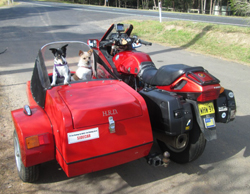1

 K100RT Ergonomics and Handlebar Adjustments Sun Mar 16, 2014 2:27 pm
K100RT Ergonomics and Handlebar Adjustments Sun Mar 16, 2014 2:27 pm
AJ.Valente
Life time member

After taking a long look at the RT it seems the designers created options to accommodate rider height, only this is not reflected in the literature. Almost from the beginning there were reports of wind noise at high speed, a condition for which BMW seemingly had no answer. In actuality, the adjustment is a rather small and often goes overlooked.
Upon examining dozens of marketing photos, assembly instructions, contemporary articles, etc., one thing stands out--RT handlebars were set by the factory to the highest position, about 7-9" above the faring lip. An upright posture was deemed natural for touring, and since the RT was the "touring" model, this was probably why the bars were initially set so high. As handlebar adjustment isn't mentioned in the assembly instructions or the rider's manual, it seems most people accepted the factory settings without question.
(Figure 1) Faring concepts on RS and RT are very similar. In this artist drawing (modified for content) RS and RT are pictured side-by-side with streamlined fairings mounted at similar angles (note that handlebar heights are much the same). The RS windscreen ends just before the handlebars, while the RT windscreen extends further back and covers the handlebars.
The RS design called for fixed handlebars with an adjustable windscreen to match the height of the rider, while the RT was just the opposite with a fixed windscreen and adjustable handlebars.
Ideal adjustment to the windscreen(s) essentially requires the rider just peer over the lip of the canopy. On the RS a small windscreen extension may be raised or lowered, and the RT the range of handlebar adjustment is only about 3", but this small change makes all the difference in the world. Thus, on the RT taller riders will slide back in the seat, lean forward a bit, and lower the handlebars to a suitable position, while shorter riders will slide forward in the seat and adjust the handlebars up to a comfortable level.
continued . . .
Upon examining dozens of marketing photos, assembly instructions, contemporary articles, etc., one thing stands out--RT handlebars were set by the factory to the highest position, about 7-9" above the faring lip. An upright posture was deemed natural for touring, and since the RT was the "touring" model, this was probably why the bars were initially set so high. As handlebar adjustment isn't mentioned in the assembly instructions or the rider's manual, it seems most people accepted the factory settings without question.

(Figure 1) Faring concepts on RS and RT are very similar. In this artist drawing (modified for content) RS and RT are pictured side-by-side with streamlined fairings mounted at similar angles (note that handlebar heights are much the same). The RS windscreen ends just before the handlebars, while the RT windscreen extends further back and covers the handlebars.
The RS design called for fixed handlebars with an adjustable windscreen to match the height of the rider, while the RT was just the opposite with a fixed windscreen and adjustable handlebars.
Ideal adjustment to the windscreen(s) essentially requires the rider just peer over the lip of the canopy. On the RS a small windscreen extension may be raised or lowered, and the RT the range of handlebar adjustment is only about 3", but this small change makes all the difference in the world. Thus, on the RT taller riders will slide back in the seat, lean forward a bit, and lower the handlebars to a suitable position, while shorter riders will slide forward in the seat and adjust the handlebars up to a comfortable level.
continued . . .
__________________________________________________
'98 K1200RS Marrakesh Red
My old K100 RT Pics and Mods



















